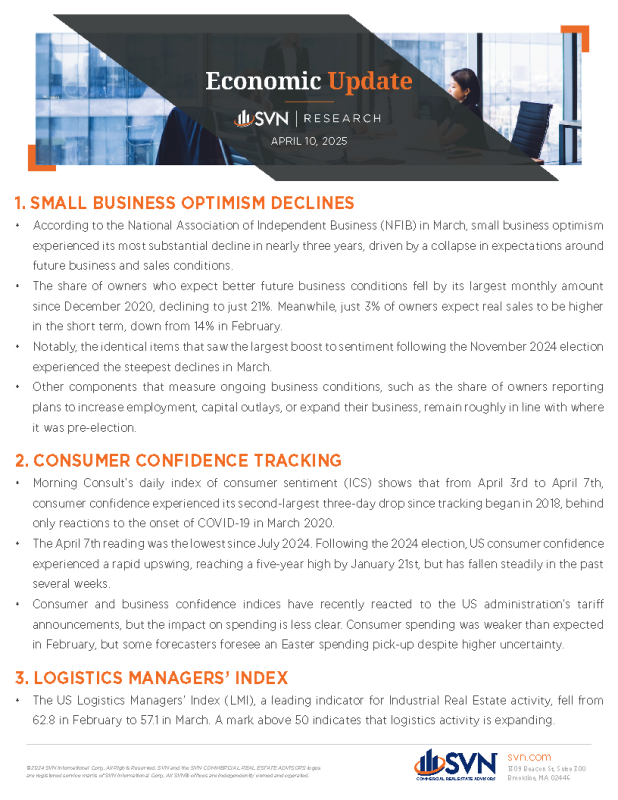1. SMALL BUSINESS OPTIMISM DECLINES
• According to the National Association of Independent Business (NFIB) in March, small business optimism experienced its most substantial decline in nearly three years, driven by a collapse in expectations around future business and sales conditions.
• The share of owners who expect better future business conditions fell by its largest monthly amount since December 2020, declining to just 21%. Meanwhile, just 3% of owners expect real sales to be higher in the short term, down from 14% in February.
• Notably, the identical items that saw the largest boost to sentiment following the November 2024 election experienced the steepest declines in March.
• Other components that measure ongoing business conditions, such as the share of owners reporting plans to increase employment, capital outlays, or expand their business, remain roughly in line with where it was pre-election.
2. CONSUMER CONFIDENCE TRACKING
• Morning Consult’s daily index of consumer sentiment (ICS) shows that from April 3rd to April 7th, consumer confidence experienced its second-largest three-day drop since tracking began in 2018, behind only reactions to the onset of COVID-19 in March 2020.
• The April 7th reading was the lowest since July 2024. Following the 2024 election, US consumer confidence experienced a rapid upswing, reaching a five-year high by January 21st, but has fallen steadily in the past several weeks.
• Consumer and business confidence indices have recently reacted to the US administration’s tariff announcements, but the impact on spending is less clear. Consumer spending was weaker than expected in February, but some forecasters foresee an Easter spending pick-up despite higher uncertainty.
3. LOGISTICS MANAGERS’ INDEX
• The US Logistics Managers’ Index (LMI), a leading indicator for Industrial Real Estate activity, fell from 62.8 in February to 57.1 in March. A mark above 50 indicates that logistics activity is expanding.
• This month’s drop is the third largest in the index’s history and marked the shortest expansion in logistics activity in seven months. However, for context, February’s LMI reading was the highest since June 2022.
• The decline was led by an across-the-board drop in index components prices, including inventory costs, warehouse prices, and transportation prices.
• The broad price decrease lends credibility to the view that logistics activity ramped up to start the year in anticipation of tariff risks, but that activity has since subsided.
• Additionally, inventory levels and warehouse and transportation capacity each expanded at a slower pace in March.
4. MEDICAL OUTPATIENT SPACES
• Medical outpatient buildings (MOB) are emerging as an opportunity in an otherwise challenging market, as explored in a recent piece by Globe Street.
• Asking rents rose 2.5% in 2024, slower than the 3.7% in 2023, but premium properties continue to drive rent growth in the sector.
• Properties with rents in the 90th percentile of Revista’s top 100 markets achieved an average of 2.4% in NOI growth between 2019 and 2024 compared to an average of 1.8% growth for properties near the 50th percentile.
• Tenant retention has also been key to MOB’s appeal. Healthcare providers typically operate on longer lease terms while renewing at high rates.
• According to data from Green Street, over 80% of tenants renewed MOBs in Q3 2024. New leases average a commitment of 107 months, nearly nine years. Meanwhile, vacancy rates remain relatively low, at just 6.9% through Q4 2024.

5. APARTMENT CONSTRUCTION & DEVELOPMENT ACTIVITY
• According to the National Multifamily Housing Council (NMHC)’s latest quarterly construction survey, 58% of respondents reported experiencing construction delays during the first quarter, down from 78% at the end of Q4 2024.
• The Southeast stands out as an area where delays are more widespread, followed by Texas and, to a slightly lesser extent, the mid-Atlantic and the Rockies.
• Of those experiencing delays during Q1, 79% are experiencing permitting delays, a drop from a record high of 95% of respondents in Q4 2024. The share of respondents reporting delays in starts rose from 90% to 93%, its highest share since June 2022.
• The most frequently cited causes of delays in starting during the first quarter were economic uncertainty and economic feasibility, each at 68% of respondents. Permitting, entitlement, and professional services are also cited to a slightly lesser extent but still affect more than half of all respondents.
• Availability of construction financing and staffing shortages continue to decline as reasons for delayed starts.
6. MARCH JOBS REPORT
• According to the Bureau of Labor Statistics (BLS), the US added 228k jobs in March, well above projections of 140k jobs and climbing from 117k in February. The unemployment rate increased 10 basis points (bps) to 4.2%.
• Health care, transportation, and warehousing were once again among the key sectors driving employment growth.
• Federal government jobs continued to shrink in March as large cuts to the federal workforce that began in February continued to take shape. Federal government jobs declined by 4,000 in March following an 11,000 decline in February.
• Despite payrolls coming in higher than expected, futures markets shifted toward a more dovish outlook for policy following the data release.
• Year-end projections for the Federal Funds rate went from a 78.7% probability of no more than four (4) rate cuts between now and the end of the year to a 51.1% probability of at least five rate cuts.
7. EASTER SHOPPING SEASON
• The National Retail Federation projects that Easter shoppers are expected to spend $23.6 billion during the spring 2025 holiday, up from the $22.4 billion estimated total in 2024.
• The report forecasts that Americans will increase their spending this year despite a recent uptick in economic uncertainty.
• Discount stores are expected to once again be the top destination for seasonal shopping. The price of eggs, a traditional item used for Easter festivities, has nearly doubled in the past year.
• Major retailers, who experienced robust sales numbers during the December 2024 holiday season, are expecting a similar pattern during the upcoming holiday, believing that consumers who feel constrained by other costs may view the holiday season more favorably.
8. TOP STATES FOR UNDER-35 HOMEOWNERS
• According to a Chandan Economics analysis of the American Community Survey, Texas, California, and Florida have the greatest number of households headed by someone under 35.
• Meanwhile, Utah (11.6%), Alaska (10.2%), and Iowa (10.1%) maintain the highest proportion of U35 homeowners as a share of all households in the nation, with North Dakota (10.0%) and Wyoming (9.6%) rounding out the top 5.
• The states with the highest totals tend to also have the most homeowners under 35 and generally rank near the top for renters.
• Conversely, the highest shares of U35 homeowners as a percent of all households reveal where young, first-time homebuyers face fewer barriers to ownership.
• States that rank in the bottom ten for a share of U35 homeowners are among some of the highest for average hourly wages. This includes DC, which is the lowest in terms of U35 homeowner share (3.5%) but highest in average hourly wage ($55.02). Also ranking in the bottom five are California (4.6%) and New York (4.8%), followed by Hawaii (5.1%) and Nevada (5.4%).
9. WFH RENTAL DEMAND
• According to a Chandan Economics analysis of the US Census Bureau’s American Community Survey, there are 4.0 million rental units in the US headed by someone who works from home (WFH), down from 4.5 million in 2022, representing a 9.9% decline.
• It’s the second consecutive year that WFH rentals have fallen, following the peak of 5.0 million households in 2021. Between 2021 and 2023, WFH rental demand has slid by a total of 1.0 million households (-20.1%).
• WFH renters skyrocketed by more than 200% in 2020 and rose again by about 18% in 2021.
• Despite the past two years of declines, the nature of remote vs. in-person work remains in a very different place than it was entering the pandemic. Through 2023, the total number of full-time WFH workers (22.6 million) remains up by 152% compared to pre-pandemic.
• The disentanglement of local rent prices from local wage dynamics had a major impact on rental markets in the aftermath of the pandemic. Now, while the reversion process will be more gradual, a re-anchoring appears underway.
10. FOMC MEETING MINUTES
• According to the recently released minutes from the Fed’s March policy meeting, there was broad agreement to keep rates unchanged while policymakers continue to assess the outlook for labor markets and growth in 2025.
• Members, on average, expect inflation to be pushed higher this year due to the impact of tariffs. However, the committee collectively acknowledges that there is much uncertainty around the magnitude of tariff effects or their duration.
• Meanwhile, a majority of officials believe that inflation pressures more broadly could be more persistent than previously anticipated.
• Most FOMC members view inflation risks as tilted to the upside, while employment risks are facing the downside.
SUMMARY OF SOURCES
• (1) https://www.nfib.com/news/press-release/new-nfib-survey-small-business-optimism-slips/
• (2) https://pro.morningconsult.com/trackers/u-s-consumer-confidence-tracker
• (3) https://www.the-lmi.com/
• (4) https://www.globest.com/2025/04/09/noi-growth-remains-strong-for-high-demand-medicaloutpatient-spaces/
• (5) https://www.nmhc.org/research-insight/nmhc-construction-survey/2025/quarterly-survey-ofapartment-construction-development-activity-march-2025/
• (6) https://www.bls.gov/news.release/pdf/empsit.pdf
• (7) https://www.fastcompany.com/91313443/easter-spending-to-increase-despite-economicuncertainty-nrf-report
• (8)https://www.chandan.com/post/top-states-for-under-35-homeowners
• (9) https://www.chandan.com/post/wfh-rental-demand-has-dropped-by-20(10) https://www.
federalreserve.gov/monetarypolicy/fomcprojtabl20250319.htm


